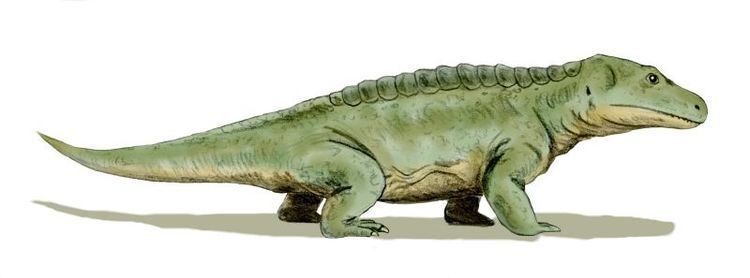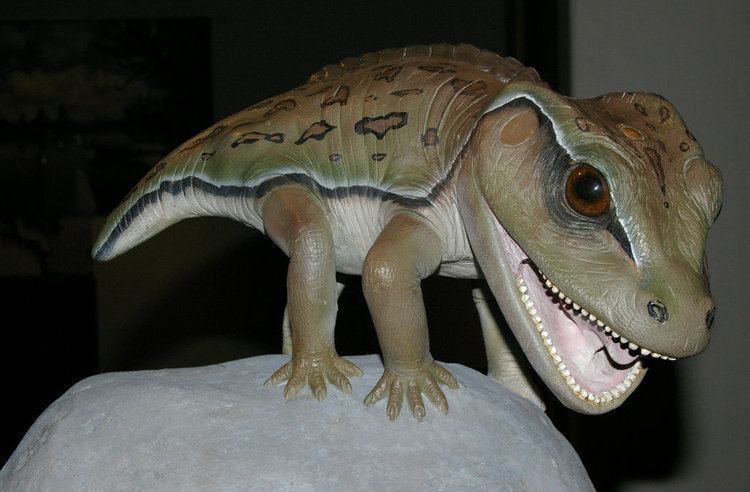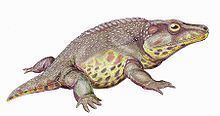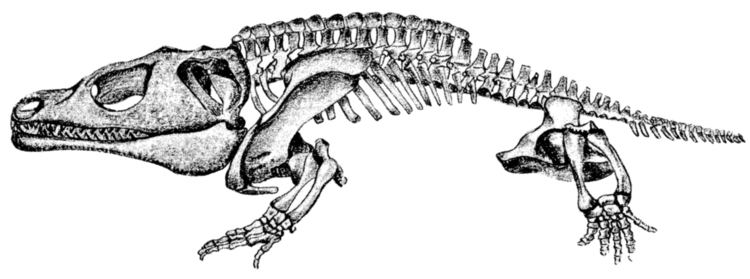Rank Genus | Phylum Chordata | |
 | ||
Similar Dissorophidae, Temnospondyli, Platyhystrix, Dissorophus, Dissorophoidea | ||
Cacops (Greek for "blind face"), a genus of dissorophid temnospondyls, is one of the most distinctive Paleozoic amphibians that diversified in the equatorial region of Pangea during the Kungurian stage of the Early Permian. Dissorophids were a group of fully terrestrial, often heavily armored predators. This contrasts with the majority of aquatic or amphibious anamniotes, which not did develop into clearly defined terrestrial adults. This, along with their relatively large size and geographical range suggest that they were able to coexist with amniotes as predators before the Permo-Triassic extinction event. Dissorophidae has two distinct clades, the miniaturized Amphibamidae and the larger terrestrial Olsoniforms. Cacops is one of the few olsoniforms whose ontogeny is beginning to surface. Cacops fossils have previously only come from the Cacops Bone Bed during the Lower Permian of Texas. However, new material collected from the Dolese Brothers Quarry, near Richards Spur, Oklahoma and the Fort Sill fissure fills has been recovered, painting a clearer picture of what the animal looked and acted like.
Contents

Description

American paleontologist Samuel Wendell Williston used the details of the species Cacops aspidephorus to first describe its features. However, because of the poor preservation of specimens collected from the Cacops Bone Bed in Texas, other researchers who collected specimens from other localities have described many of Cacops’ features with more certainty.

The skull is very box-like and its cheeks aligned almost at a right angle to the skull table. The external cranial ornament is noticeable on the skull table and on top of the ridges that border the numerous depressions. One significant ontogenetic change in Cacops is a more evenly distributed ornamentation in the adults. Another important feature of the skull is the tip of the snout, which has a teardrop shaped internarial fontanelle, evident in both adult and juvenile specimens. Like other dissorophids, the temporal region of Cacops’ skull was dominated by the tympanic embayment, which likely housed a large tympanum. Marginal teeth are recurved and thinner than in other temnospondyls. The palatal dentition consists both of recurved tusks larger than the marginal teeth and strong recurved teeth that cover most of the palatal surface.

Cacops was about 40 cm long. There is a change in shape and height of the presacral neural spine as you proceed posteriorly along the vertebral column. There are two sacral vertebrae and the pleurocentrum of the first sacral vertebrae is noticeably smaller that the rest. All internal osteoderms are fused to the neural spines. The osteoderms are associated with only the first 15 vertebrae, beginning at the axis. The lateral margin of each osteoderm can either be bluntly pointed or rounded. The osteoderms also have dermal pitting, each varying in size and depth. The distributions of these pits are not random, but rather found along the raised edges of the midsagittal groove and often in the groove as well. The ventral surface of both series of osteoderms does not have either grooves or pitting
History of discovery

Cacops aspidephorus is the most famous dissorophid, in part due to a majority of its skeleton having been known for about a century. Over 50 specimens have been found in the Cacops Bone Bed in Baylor County, Texas. However, many of the specimens are covered in calcite, which penetrates the bone tissue, resulting in poor preservation. Additional findings have been found in the Vale formation and Choza formation of Texas and the Richards Spur locality in Oklahoma. Current specimens show the range of armor in C. aspidephorus consists of paired tubercles to spatulate-shaped dermal ossifications.
Cacops morrisi is named in honor of Tony Morris, who discovered one of its two specimens. Many specimens have been found in the Dolese Brothers Quarry, near Richards Spur, Oklahoma. This locality is known for having perfectly preserved isolated bones of many different amphibians. C. morrisi has a skull that differs only minutely in comparison to C. aspidephorus. However, a couple features that distinguish C. morrisi from C. aspidephorus are the snout, which is slightly longer than its post-orbital region, and the distance between its orbit and temporal emargination, which is reduced.
Cacops woehri is named in honor of Daniel Woehr, who is an amateur collector of fossils. Specimens have been found in the Dolese Brothers Quarry, near Richards Spur, Oklahoma. C. woehri differs from C. aspiephorus and C. morrisi for many reasons, some being its more shallow shaped skull, more dorsally located orbits and narrow opening of its tympanic embayment. The contribution of the post parietals to the skull roof also appears to be shorter in C. woehri than in C. morrisi. More notable differences distinguishable from C. morrisi include: absence of lateral exposure of ectopterygoid in juveniles, absence of tusk-like teeth on the anterior margin of the interpterygoid vacuities, and the quadratojugal lacking an anterior process.
The teeth of C. woehri are also not recurved as in C. aspiephorus and C. morrisi, showing instead a distinct lingual curvature. Because of the different skull shape, it is theorized that this specific taxon may have had a different ecology than its sister taxa, possibly with a different prey spectrum. More recent finds have also shown that in contrast to C. aspiephorus and C. morrisi, C. woehri retains the overall skull morphology into adult stages. This suggests that there could have been different functional demands for the dissorophoids found at the Oklahoma locality
Predation
The skull of Cacops has several features associated with predatory behavior, indicating that it may have been one of the top terrestrial predators of its time. There are tooth covered transverse flanges on the pterygoid that extend below the level of the marginal tooth row, probably for capturing and holding struggling prey. There are also recent fossil discoveries suggesting Cacops fed on large varanopid synapsids.
Cacops provides the oldest evidence of a tympanic membrane in terrestrial vertebrates. Among modern amniotes, sensory perception requires a specialized middle ear that collects airborne sounds through a tympanic membrane and delivers the vibrations to the inner ear via multiple structures, including the stapes. Thus, the discovery of a slender stapes in Cacops aspidephorus suggested that Cacops had an ability to hear airborne sound. The presence of a tympanum in contemporary amniotes is a difference between these terrestrial vertebrates that suggests these two groups had very different abilities to hear airborne sound. This type of hearing is important for both prey detection and intraspecific communication.
Locomotion
Two series of osteoderms of the presacral vertebral column impact the biomechanics of the axial skeleton. Cacops have an internal series, which consist of an osteoderm fused to the distal tips of each neural spine and an external series, which lie dorsal to the segments of the internal series. The portions of the vertebral column with osteoderms had limited lateral flexion, thus limiting lateral movement. Cacops may have had the ability to move forward in short running spurts. However, it was not able to hop or leap due to its short hind limbs. It may have also used a symmetrical walk similar to modern crocodilians or salamanders, in which its body is supported by opposite movements of the front and hind limbs.
Paleoecology
The global geography of the Early Permian included massive areas of land and water, with the earths crust plates still being fused together forming a supercontinent known as Pangea. Most continents met in Pangea, accounting for the few number of Cacops specimens found in Russia and China today. Current models indicate that a majority of the supercontinent was extremely dry, with great seasonal fluctuation caused by the surrounding large bodies of water.
This was also a time of plant and insect diversification. . Some people believe that in addition to small animals, Cacops also fed on insects. It is also believed that they hunted at night, to avoid the larger predators.
